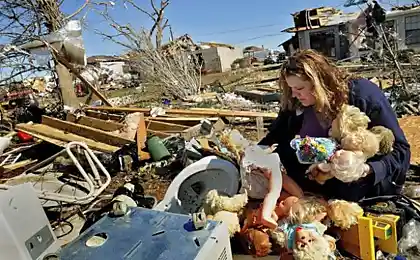593
The demographic aggression of the United Nations: the question of security of parenthood and childhood
Twenty million seven hundred ninety one thousand eight hundred eighty two
At the end of 2014 the United Nations population Fund (UNFPA) published its latest report on the state of the world's population. This time the report was devoted to youth issues, which is reflected in the title – "the Power of 1.8 billion. Teenagers, youth and the transformation of the future" ("The Power of 1.8 Billion. Adolescents, Youth and the Transformation of the Future”).
Like many previous UN publication, the report boils down to aggressive Malthusian rhetoric, according to which the world too many people. In this case the UN experts are concerned about the number of young people. However, the authors of the report not so much worried about the growing number of adolescents and young people, as the fact that this growth is happening outside the so-called developed countries. "In our world is home to 1.8 billion young people aged 10 to 24 years and the fastest growing youth population in the poorest countries. Part of this generation consists of 600 million adolescent girls with specific needs, problems and aspirations for the future," said in a Foreword to the report.
Chasing the target demographic of deterrence by expanding the so-called reproductive rights (the introduction of contraception, sterilization, abortion and corrupting sex education programmes) worldwide, the authors have caused widespread criticism from independent experts and supporters of traditional family values.
The experts from the new York Center for family and human rights (C-Fam) in his characteristics of the report used the phrase "sexual anarchy".[1]
After reviewing the report, the President of the American Institute of research on population Steven Mosher has accused the UN population Fund and sympathetic journalists in the promotion of adolescent abortion, violation of the rights of parents and endangerment to children.[2]
The Acton Institute (Acton Institute), located in Rome, published an article-a review on demographic UNFPA initiative, which clearly raises the question whether the position of the UN in this case "patron" and "colonialist", when it is argued that too many people in developing countries – bad for everyone else.[3] moreover, on the website of the Institute reported that the number of claims in the UNFPA report does not contain any references and evidence.
Sexual integrity of children as an "obstacle»
Fully agreeing with the statements about the aggressive and biased nature of the document, as well as one-sided interpretation of reality, should be to focus on his academic bankruptcy and outright misinformation. Literally from the first page of the report, there are very controversial statements that have no scientific basis. So, on page 3 of the English version of the report without any reference or explanation States the following: "Studies show that when people have a choice, they tend to choose a small family." A similar statement without appealing to any sources can be found on page 16.
However, the greatest outrage is the desire of the authors to impose a traditionally oriented part of humanity that represents the majority of the world population, socio-demographic concepts that are contrary to cultural, moral and religious principles. Proposed by UN experts, social-legal "innovations" threaten not only for demographic security, but also the very institution of traditional monogamous family.
Special attention deserves the third Chapter entitled "obstacles to the growth and realization of potential of young people", in which the UN transferred to antenatalnuu social engineering. Put in sequential order a few quotes:
"The laws governing the age of consent, lets Teens under 18 years to access needed services and information in reproductive health" (p. 35 of the English version of the report);
"Access to high-quality modern sex education remains elusive for most adolescents. Although many countries have policies of modern sex education and have the appropriate programs, most of them are not implementing them on a broad scale or at a level that meets international standards" (p. 37 of the English version of the report);
"In addition to this knowledge, young people need a wide range of services in sexual and reproductive health, including protection from teenage pregnancy, care of pregnant adolescents, AIDS prevention, testing, counselling, treatment and care, provision of vaccines against HPV and safe abortion" (p. 37 of the English version of the report);
"Teenagers and young women in need of safe abortion and post-abortive support, face problems of access in many countries" (p. 38 of the English version of the report);
"Access to condoms for prevention of AIDS and sexually transmitted diseases, is a critical prevention strategy, but very few young men and women use them" (p. 38 of the English version of the report), etc.
So, starting with the claim to the laws protecting children and adolescents from sexual abuse (the pedophiles applaud), the authors move on to the need of wide introduction of so-called sexual education, access to contraception, abortion, HPV vaccines, etc.
Maniacal aspiration of the authors at any cost to impose to children and adolescents what most of them because of their age do not need, in our view, contributes to child abuse and has a strong advocacy character. Many probably realize that the promotion of so-called sex education has certain commercial effects. In particular, it automatically increases demand for the products of pornography, contraception, abortion, the range of sex shops, which promise a lot of income relevant to transnational companies.
So, the report explicitly States about the need to expand the market of contraception: "Access to prevention of contraception means that you can get contraceptive services. Until now, teenage girls have low access to contraception, resulting in their use of contraception is only 22%, while among women older than 30 years, the figure is 60%" (page 37 of the English version of the report). In other words, a colossal and quite logical difference in use of contraception between the age groups, according to the logic of the authors, represents a significant field of activity. No doubt, profit from the expansion of the task force will annually be calculated on a ten-digit sums in dollar terms.
However, let's look more euphonious such phrases as "safe abortion" and "access to condoms" in the context of "a critical prevention strategy", which is so strongly (unfortunately, not convincing), it tells the authors of a controversial UN report.
What is a "safe abortion"?
With respect to abortion and their "security," that the whole incident is that the world health organization (who), the competence of which is the issue, does not give interpretations of the term "safe abortion" (safe abortion), although quite often uses this phrase. The who actively interpreterpath the term "unsafe abortion" (unsafe abortion), which is defined as the procedure for termination of an unwanted pregnancy performed by persons lacking the required qualifications and / or conditions that do not meet medical standards.[4]
The definition of "safe abortion" is not even in the who publications in which the term in the title. Oddly enough, but such a definition is not even in the volume of the who guidelines entitled "Safe abortion: technical and policy guidance for health systems"[5] ("Safe abortion: technical and policy guidance for health systems") from 2012. There is no such definition in the Russian language publication of the who from 2004 entitled "Safe abortion: Guidance for health systems policy and practice", where the authors are avoiding a clear definition of the concept of "safe abortion" forced upon women around the world are limited to very ornate and very cautious phrase: "If abortion be engaged in by qualified medical personnel, using adequate equipment, correct technique and sanitary standards, abortion is one of the safest medical interventions".[6]
Feel the difference? Abortion is not safe, and one of the safest medical interventions. Thus, who, systematically promoting the idea of "safety" of abortion in tandem with UNFPA and other international organizations (USAID, the bill and Melinda gates Foundation, International planned parenthood Federation, etc.), and even placing this mysterious term in the title of their official publications, nor never had the courage to give the relevant definition and, moreover, to recognize the abortion procedure safe. We are talking in best case about reducing the risks, but not about reaching the safety of abortion.
In our view, it is also significant that in the English version of the famous electronic encyclopedia "Wikipedia" also contains a section called "Safe abortion" "Safe abortion", but there is a section on "Abortion" ("Abortion"), subsection "Safety" ("Safety") and a separate section called "Unsafe abortion" ("Unsafe abortion"). In none of the sections and subsections all-knowing Wikipedia there is again no interpretation of "safe abortion". Instead, in the section "Abortion" (subsection "Safety") with reference to medical journal "The Lancet", American College of physicians and the who includes the following text: "the health Risks posed by abortion depend on whether the procedure is safe or unsafe. The world health organization defines unsafe abortions as those performed by unskilled individuals, with hazardous equipment, or in unsanitary conditions. Legal abortion, carried out in developed countries, are among the safest procedures in medicine."[7]
Similarly, Wikipedia's "Unsafe abortion" with reference to the who, UNFPA, Institute of Alan Guttmacher and publications of Indian and Western experts, contains the following sentences: "Unsafe abortion is the termination of pregnancy by people lacking the necessary skills or in conditions that do not meet minimal medical standards, or the presence of both. For example, unsafe abortion can be an extremely dangerous procedure life threatening, if you are alone in unsanitary conditions, or abortion can be safer when done by a doctor that is not providing proper care after the abortion.
Unsafe abortions are a significant cause of maternal mortality and morbidity in the world. Most unsafe abortions occur where abortion is illegal, or in developing countries where the availability of well-trained doctors is not always the case, or where modern contraceptives are unavailable. About one in eight deaths worldwide related to pregnancy, is associated with unsafe abortion."[8]
In fact, the above variations to a certain extent reflects the previous definition of unsafe abortion the who, which appeared in 1992 and reads as follows: "Unsafe abortions are characterized by lack of or insufficient qualifications of the person conducting the abortion, dangerous equipment and unsanitary conditions."[9] the authors of all these publications who strenuously avoid a clear interpretation of the term "safe abortion", as if offering to proceed by contradiction, i.e. from the definition of "unsafe abortion".
From the above it can be concluded that the so-called "safe abortion", according to the supporters of this term is the termination of pregnancy performed by a physician in a medical facility with the appropriate equipment and proper techniques in a country where abortion is legal. By the way, very similar to the interpretation we have seen in the section "Abortion" Russian Wikipedia[10], which contains almost the only Russian-speaking Internet in an attempt to give an appropriate definition of the mythical to the term "safe abortion". However, in the Russian version of Wikipedia refers not to medical or scientific sources, and to some Coalition for reproductive choice "the Grapes of ash" which, as stated on its website, is an informal network, which seeks to reduce maternal morbidity and mortality, etc. [11] According to the above source, the abortion is said to be safe if performed by a trained specialist (doctor, midwife, nurses) using approved and recommended methods and in a proper medical facility[12]
Whether so it actually? Whether abortion is committed on fulfilling all the above conditions, safe?
Oddly enough, but the answer to this question not so long ago gave themselves the who. The answer was clear and negative. It happened in the spring of 2014, when in one of the newsletters who got a small but very important material authored by six representatives of the Department of reproductive health and research who. Text material in the form of official statements released under the title "From concept to concrete measures: operationalization of the definition of who to unsafe abortions" ("From concept to measurement: operationalizing whoís definition of unsafe abortion"). Below are quotes that gives a detailed explanation of specialists who on the so-called "safe abortion".
"The who definition of unsafe abortion was made at the arising of the guidelines in relation to complications of induced abortion and was intended to be interpreted in this context. This relationship with the technical principles for the management of abortion is crucial for its correct interpretation. Nothing in the definition does not prejudge who should be considered "safe" by abortion and what should be the appropriate skills and standards to perform abortions. Such things are not static; they evolve in accordance with evidence-based who recommendations.
... Despite the fact that unsafe abortion is defined as a risky security cannot be separated because the risk is always there. The risk is the lowest, and if a proven method is used to abort early pregnancies in a medical facility; the risk is highest if you use a dangerous way, such as the use of caustic substances orally or vaginally, or introduction of objects into the uterus for termination of pregnancy. There are a range of risks between these two extremes. In this range there are, for example, cases of self-administration of misoprostol in the supine position or the use of outdated treatments like dilatation and curettage, by skilled health personnel.
...widespread informal use of misoprostol has added a new level of complexity to the concept of "security". In the result there is a need to use multivariate analysis of risk to measure the safety of abortion... Multidimensional evaluation of the safety of abortion, as proposed, makes the assessment more difficult…
Existing safety assessments of induced abortions is not enough…»
Not being able to give here the full text of the specified statements to the limited length of this article, we point out also that from the position of experts cited above it follows that the legalization of abortion does not make them safe.
As it turned out, "safety of abortion" is a classic manipulation of the senses. From the above positions professionals profile Department who directly follows that safe abortions do not happen because, as mentioned above, "the risk is always there". Now it becomes clear why the proponents of "safe abortion" is so carefully avoided in their specific definition.
Note that the experts of the UNFPA report that contains repeated calls for the provision of "safe abortion", 13 times directly refer to the world health organization. It is doubtful that at such close attention to the authors of the report to the who sources, they were not known to the above the position of its experts, refutes the safety of abortion.
The opposite effect of condoms
Even more interesting is the case with "access to condoms" for children and adolescents, which so furiously insist demographic managers of the UN.
In 2005-2006, the British multinational company HBSC in collaboration with who conducted a study of the behavior of school-age children in the field of health. The experts evaluated the indicators of the health of children and adolescents and its influencing factors in 41 countries. In a report published on the results of this study, see key findings in health, 11, 13 and 15 year old children. One of the results of the study is to determine the level of condom use among 15-year-old. According to the report, the highest level of condom use among 15-year-old was observed at that time in Spain. Usage of condom during last sexual intercourse in this country was reported by 95% of girls and 83% boys.[13] it would Seem that the level of protection against STDs in Spain should be higher. Let's see how justified these expectations (See. Figure 1).
Sixty eight million eighty nine thousand five hundred forty six
Source: World Health Organization. CISID. Data on sexually transmitted infections (STI)
* Data for a herpes infection in Spain for 2008 in the above database are not available.
As seen in Chart 1, a high level of use of barrier contraception in Spain not only not protects from STDs, but, on the contrary, provokes a rise in sexually transmitted diseases. This statement in various degrees true, at least for such infections as hepatitis B, herpes, syphilis and chlamydia. Let us cite the opinion of Professor in the field of preventive medicine and public health Hocine de Irala (University of Navarra, Spain): "the Most common patients venereal disease – people who had 20 or more sexual partners. The role of condoms, in this case, mythologized(emphasis added), because they are not highly effective in terms of prevention of a number of infections – chlamydia, herpes, cytomegalovirus, human papillomavirus (HPV), etc. Aggressive marketing of condoms, creating the illusion of security, provoke young people to more risky sexual contacts. Meanwhile, according to risk, five sexual contacts with a condom equal to the one of sexual contact without. The most cunning deception is the myth of "safe" sex, which supposedly provides contraception. In fact, the scientific evidence tell us that truly safe sex is possible only in marriage provided that the spouses are faithful to each other".[14] for Example, the probability of becoming infected with HPV for women whose partner is a hundred percent of the time use condom, more than 37%. One of the frequent consequences of this virus is cervical cancer.[15]
Will not be superfluous to note that Spain has one of the lowest birth rates in Europe. The total fertility rate in this country is only 1.32 children per woman of reproductive age[16], which is 1.6 times below the basic level of generation replacement.
Summary
In connection with the foregoing, in our opinion, it is necessary not only to rethink the feasibility of the malicious provisions of a number of international instruments on our territory, but the very participation of Russia in a number of international institutions. This primarily concerns the United Nations Fund for population, under the heading which was published a controversial report on "the Power of 1.8 billion. Teenagers, youth and the transformation of the future".
Reviewed the UNFPA report, generously funded, including from the Russian budget, openly promoting risky sexual behavior, fertility decline and destruction of family relationships. While a significant advantage of Russian and foreign opponents of UNFPA is its gross ignorance in matters of demography. So, arguing about the numerous adolescents and young people on the planet, the report's authors did not even bother to read the chronology of demographic dynamics over the past decades, which convince in the rapid fall in the proportion of children and young people in the total world population. However, the authors of the report worried about is not the abstract "a large number" of teenagers and youth, but its numerical superiority outside of developed countries, including the USA and European countries.
The aggressive tone of the report was not only in calling for the reduction of the population of entire continents, but even worse, undermining parent-child relations and traditional. Hindrances to the realization of "reproductive rights" of teenagers and young people were named by their parents, tradition, and religious organizations. The authors of the report directly promote abortion for adolescents (without parental consent) and young people, the spread of contraception among children and adolescents engaging in early sex, lower age of sexual consent (which is clearly in the hands of pedophiles) and sexual education, inevitably leading to the reduction of fertility, sexual deviations and increased demand for pornographic material.
In General, the document has a strong lobbying nature and objectives of demographic containment of the unwanted along with the commercial interests of the global contraceptive and other corporations. The phrase "reproductive health", under the mask of which move above the destructive initiatives can be found in the report 150 times.
Against this background, causes considerable surprise to the systematic funding of UNFPA from the Government of the Russian Federation. If in 1996 the annual contribution of our country to UNFPA amounted to 150 thousand dollars[17] by 2006, this amount is doubled[18], and to date the expenditure part of the Russian Federation in financing only one of the projects implemented in Belarus from UNFPA, is 900 thousand dollars.[19] in Russia the official mission of UNFPA, the leading relevant activities on our territory for many years. In addition, at the end of 2014, the regional Director of the UN Fund for population for Eastern Europe and Central Asia, Heimo LAAKKONEN said that negotiations on the financing of the Russian side of UNFPA projects in Tajikistan and Kyrgyzstan.[20]
In light of the foregoing, there is an imperative necessity of ending the financial and any other of Russia's participation in UNFPA activities, and other similar structures.
We believe that amid the current situation in the sphere of international relations Russia has a unique chance not only for the implementation of the sovereign family-demographic policy, but also for foreign policy activities for the protection of traditional moral values, approval by a majority of the world's population. Specified range of issues our country has many allies, who see Russia as one of the strongholds of the family of the foundations of human civilization.
Today, it is impermissible to forget that the observed confrontation between Russia and the West, as well as traditional and modernist Outlook throughout the world, has several dimensions, including demographic. In this context, the protective measures against aggression against fatherhood, motherhood and childhood, both at the national and at the global level, no less important than strengthening the defense in order to repel a possible military aggression. published
With the full version of the report "the Power of 1.8 billion. Teenagers, youth and the transformation of the future" can be found on the official website of the United Nations population Fund: English www.unfpa.org/sites/default/files/pub-pdf/EN-SWOP14-Report_FINAL-web.pdf ;in Russian – http://www.unfpa.org/sites/default/files/pub-pdf/RU-SWOP14-Report%20Rev-Web-update%2024%20Nov.pdf
Author: Igor Beloborodov, PhD in sociology
[1] C-Fam. UNFPA: Children have right to sex, drugs, abortion to reduce population. November 20, 2014. URL: https://c-fam.org/friday_fax/unfpa-children-right-sex-drugs-abortion-reduce-population
[2] Media Research Center. Media Commit ‘Cultural Imperialism’ in UN Report Pushing Abortion for Teens. November 19, 2014. URL:http://www.mrc.org/articles/media-commit-cultural-imperialism-un-report-pushing-abortion-teens
[3] Acton Institute PowerBlog. The Power Of Youth, But Let's Not Get Carried Away. November 25, 2014. URL:http://blog.acton.org/archives/74249-power-youth-lets-not-get-carried-away.html
[4] World Health Organization. Sexual and reproductive health. Preventing unsafe abortion. URL:http://www.who.int/reproductivehealth/topics/unsafe_abortion/hrpwork/en/
[5] World Health Organization. Safe abortion: technical and policy guidance for health systems. 2012.URL:http://apps.who.int/iris/bitstream/10665/70914/1/9789241548434_eng.pdf
[6] world health organization. Regional office. "Safe abortion: Guidance for health systems policy and practice." 2004, p. 15. URL:http://www.euro.who.int/__data/assets/pdf_file/0018/125370/WQ440r.pdf
[7] The Free Encyclopedia Wikipedia. Abortion. URL:http://en.wikipedia.org/wiki/Abortion#cite_note-grimes-overview-61
[8] The Free Encyclopedia Wikipedia Unsafe abortion. URL:http://en.wikipedia.org/wiki/Unsafe_abortion#cite_note-1
[9] World Health Organization. Maternal Health and Safe Motherhood Programme. The prevention and management of unsafe abortion: report of a technical working group (WHO/MSM/92.5). Geneva: World Health Organization; 1993. Page 3. URL:http://whqlibdoc.who.int/hq/1992/WHO_MSM_92.5.pdf
[10]the Free encyclopedia Wikipedia. Abortions. URL: https://ru.wikipedia.org
[11] Coalition for reproductive choice "the Grapes of ash" URL: http://za-vybor.ru/ru/2011-07-29-15-36-49/177-vidy-metody-aborta
[12] ibid.
[13] World Health Organization. Inequalities in Young People's Health. HBSC International Report from the 2005/2006 Survey. WHO Europe, 2008. Page 152. URL:http://www.euro.who.int/__data/assets/pdf_file/0005/53852/E91416.pdf?ua=1
[14] European Congress of family education in the quotations of the participants. 16.10.2013. URL: http://riss.ru/analitika/2178-evropejskij-kongress-semejnogo-obrazovaniya-v-tsitatakh-uchastnikov#.VL5Nt6PWicw ; Jokin de Irala, MD, MPH, PhD, Cristina Lopez, MD, PhD. Presentation “Prevention and Risk Compensation. Are some public health responses to AIDS and other STIs failing?”. IEEF-EIFLE congress. Paris. 4-5 October 2013.
[15] Jokin de Irala, MD, MPH, PhD, Cristina Lopez, MD, PhD. Presentation “Prevention and Risk Compensation. Are some public health responses to AIDS and other STIs failing?”. IEEF-EIFLE congress. Paris. 4-5 October 2013.
[16] Eurostat. Fertility Indicators. Total Fertility Rate. URL:http://appsso.eurostat.ec.europa.eu
[17] the Decree of the RF Government of 20 November 1995 No. 1604-R. URL:http://www.alppp.ru/law/mezhdunarodnye-otnoshenija--mezhdunarodnoe-pravo/73/rasporjazhenie-pravitelstva-rf-ot-20-11-1995--1604-r.pdf
[18] the DECREE of the RF Government dated 07.02.2006 No. 141-R "ABOUT establishment of the 2006 ANNUAL VOLUNTARY CONTRIBUTION of the RUSSIAN FEDERATION TO the budget of the UN FUND FOR POPULATION". URL:http://www.zonazakona.EN/law/ukaz/449/
[19] RIA Novosti. Russia will Finance the demographic project in Belarus. 03.12.2014. URL: ria.ru/economy/20141203/1036368943.html
[20] ibid.
Source: www.riss.ru/demography/famille/4149-demograficheskaya-agressiya-oon-k-voprosu-o-bezopasnosti-roditelstva-i-detstva#.VPBUArCsWnH
At the end of 2014 the United Nations population Fund (UNFPA) published its latest report on the state of the world's population. This time the report was devoted to youth issues, which is reflected in the title – "the Power of 1.8 billion. Teenagers, youth and the transformation of the future" ("The Power of 1.8 Billion. Adolescents, Youth and the Transformation of the Future”).
Like many previous UN publication, the report boils down to aggressive Malthusian rhetoric, according to which the world too many people. In this case the UN experts are concerned about the number of young people. However, the authors of the report not so much worried about the growing number of adolescents and young people, as the fact that this growth is happening outside the so-called developed countries. "In our world is home to 1.8 billion young people aged 10 to 24 years and the fastest growing youth population in the poorest countries. Part of this generation consists of 600 million adolescent girls with specific needs, problems and aspirations for the future," said in a Foreword to the report.
Chasing the target demographic of deterrence by expanding the so-called reproductive rights (the introduction of contraception, sterilization, abortion and corrupting sex education programmes) worldwide, the authors have caused widespread criticism from independent experts and supporters of traditional family values.
The experts from the new York Center for family and human rights (C-Fam) in his characteristics of the report used the phrase "sexual anarchy".[1]
After reviewing the report, the President of the American Institute of research on population Steven Mosher has accused the UN population Fund and sympathetic journalists in the promotion of adolescent abortion, violation of the rights of parents and endangerment to children.[2]
The Acton Institute (Acton Institute), located in Rome, published an article-a review on demographic UNFPA initiative, which clearly raises the question whether the position of the UN in this case "patron" and "colonialist", when it is argued that too many people in developing countries – bad for everyone else.[3] moreover, on the website of the Institute reported that the number of claims in the UNFPA report does not contain any references and evidence.
Sexual integrity of children as an "obstacle»
Fully agreeing with the statements about the aggressive and biased nature of the document, as well as one-sided interpretation of reality, should be to focus on his academic bankruptcy and outright misinformation. Literally from the first page of the report, there are very controversial statements that have no scientific basis. So, on page 3 of the English version of the report without any reference or explanation States the following: "Studies show that when people have a choice, they tend to choose a small family." A similar statement without appealing to any sources can be found on page 16.
However, the greatest outrage is the desire of the authors to impose a traditionally oriented part of humanity that represents the majority of the world population, socio-demographic concepts that are contrary to cultural, moral and religious principles. Proposed by UN experts, social-legal "innovations" threaten not only for demographic security, but also the very institution of traditional monogamous family.
Special attention deserves the third Chapter entitled "obstacles to the growth and realization of potential of young people", in which the UN transferred to antenatalnuu social engineering. Put in sequential order a few quotes:
"The laws governing the age of consent, lets Teens under 18 years to access needed services and information in reproductive health" (p. 35 of the English version of the report);
"Access to high-quality modern sex education remains elusive for most adolescents. Although many countries have policies of modern sex education and have the appropriate programs, most of them are not implementing them on a broad scale or at a level that meets international standards" (p. 37 of the English version of the report);
"In addition to this knowledge, young people need a wide range of services in sexual and reproductive health, including protection from teenage pregnancy, care of pregnant adolescents, AIDS prevention, testing, counselling, treatment and care, provision of vaccines against HPV and safe abortion" (p. 37 of the English version of the report);
"Teenagers and young women in need of safe abortion and post-abortive support, face problems of access in many countries" (p. 38 of the English version of the report);
"Access to condoms for prevention of AIDS and sexually transmitted diseases, is a critical prevention strategy, but very few young men and women use them" (p. 38 of the English version of the report), etc.
So, starting with the claim to the laws protecting children and adolescents from sexual abuse (the pedophiles applaud), the authors move on to the need of wide introduction of so-called sexual education, access to contraception, abortion, HPV vaccines, etc.
Maniacal aspiration of the authors at any cost to impose to children and adolescents what most of them because of their age do not need, in our view, contributes to child abuse and has a strong advocacy character. Many probably realize that the promotion of so-called sex education has certain commercial effects. In particular, it automatically increases demand for the products of pornography, contraception, abortion, the range of sex shops, which promise a lot of income relevant to transnational companies.
So, the report explicitly States about the need to expand the market of contraception: "Access to prevention of contraception means that you can get contraceptive services. Until now, teenage girls have low access to contraception, resulting in their use of contraception is only 22%, while among women older than 30 years, the figure is 60%" (page 37 of the English version of the report). In other words, a colossal and quite logical difference in use of contraception between the age groups, according to the logic of the authors, represents a significant field of activity. No doubt, profit from the expansion of the task force will annually be calculated on a ten-digit sums in dollar terms.
However, let's look more euphonious such phrases as "safe abortion" and "access to condoms" in the context of "a critical prevention strategy", which is so strongly (unfortunately, not convincing), it tells the authors of a controversial UN report.
What is a "safe abortion"?
With respect to abortion and their "security," that the whole incident is that the world health organization (who), the competence of which is the issue, does not give interpretations of the term "safe abortion" (safe abortion), although quite often uses this phrase. The who actively interpreterpath the term "unsafe abortion" (unsafe abortion), which is defined as the procedure for termination of an unwanted pregnancy performed by persons lacking the required qualifications and / or conditions that do not meet medical standards.[4]
The definition of "safe abortion" is not even in the who publications in which the term in the title. Oddly enough, but such a definition is not even in the volume of the who guidelines entitled "Safe abortion: technical and policy guidance for health systems"[5] ("Safe abortion: technical and policy guidance for health systems") from 2012. There is no such definition in the Russian language publication of the who from 2004 entitled "Safe abortion: Guidance for health systems policy and practice", where the authors are avoiding a clear definition of the concept of "safe abortion" forced upon women around the world are limited to very ornate and very cautious phrase: "If abortion be engaged in by qualified medical personnel, using adequate equipment, correct technique and sanitary standards, abortion is one of the safest medical interventions".[6]
Feel the difference? Abortion is not safe, and one of the safest medical interventions. Thus, who, systematically promoting the idea of "safety" of abortion in tandem with UNFPA and other international organizations (USAID, the bill and Melinda gates Foundation, International planned parenthood Federation, etc.), and even placing this mysterious term in the title of their official publications, nor never had the courage to give the relevant definition and, moreover, to recognize the abortion procedure safe. We are talking in best case about reducing the risks, but not about reaching the safety of abortion.
In our view, it is also significant that in the English version of the famous electronic encyclopedia "Wikipedia" also contains a section called "Safe abortion" "Safe abortion", but there is a section on "Abortion" ("Abortion"), subsection "Safety" ("Safety") and a separate section called "Unsafe abortion" ("Unsafe abortion"). In none of the sections and subsections all-knowing Wikipedia there is again no interpretation of "safe abortion". Instead, in the section "Abortion" (subsection "Safety") with reference to medical journal "The Lancet", American College of physicians and the who includes the following text: "the health Risks posed by abortion depend on whether the procedure is safe or unsafe. The world health organization defines unsafe abortions as those performed by unskilled individuals, with hazardous equipment, or in unsanitary conditions. Legal abortion, carried out in developed countries, are among the safest procedures in medicine."[7]
Similarly, Wikipedia's "Unsafe abortion" with reference to the who, UNFPA, Institute of Alan Guttmacher and publications of Indian and Western experts, contains the following sentences: "Unsafe abortion is the termination of pregnancy by people lacking the necessary skills or in conditions that do not meet minimal medical standards, or the presence of both. For example, unsafe abortion can be an extremely dangerous procedure life threatening, if you are alone in unsanitary conditions, or abortion can be safer when done by a doctor that is not providing proper care after the abortion.
Unsafe abortions are a significant cause of maternal mortality and morbidity in the world. Most unsafe abortions occur where abortion is illegal, or in developing countries where the availability of well-trained doctors is not always the case, or where modern contraceptives are unavailable. About one in eight deaths worldwide related to pregnancy, is associated with unsafe abortion."[8]
In fact, the above variations to a certain extent reflects the previous definition of unsafe abortion the who, which appeared in 1992 and reads as follows: "Unsafe abortions are characterized by lack of or insufficient qualifications of the person conducting the abortion, dangerous equipment and unsanitary conditions."[9] the authors of all these publications who strenuously avoid a clear interpretation of the term "safe abortion", as if offering to proceed by contradiction, i.e. from the definition of "unsafe abortion".
From the above it can be concluded that the so-called "safe abortion", according to the supporters of this term is the termination of pregnancy performed by a physician in a medical facility with the appropriate equipment and proper techniques in a country where abortion is legal. By the way, very similar to the interpretation we have seen in the section "Abortion" Russian Wikipedia[10], which contains almost the only Russian-speaking Internet in an attempt to give an appropriate definition of the mythical to the term "safe abortion". However, in the Russian version of Wikipedia refers not to medical or scientific sources, and to some Coalition for reproductive choice "the Grapes of ash" which, as stated on its website, is an informal network, which seeks to reduce maternal morbidity and mortality, etc. [11] According to the above source, the abortion is said to be safe if performed by a trained specialist (doctor, midwife, nurses) using approved and recommended methods and in a proper medical facility[12]
Whether so it actually? Whether abortion is committed on fulfilling all the above conditions, safe?
Oddly enough, but the answer to this question not so long ago gave themselves the who. The answer was clear and negative. It happened in the spring of 2014, when in one of the newsletters who got a small but very important material authored by six representatives of the Department of reproductive health and research who. Text material in the form of official statements released under the title "From concept to concrete measures: operationalization of the definition of who to unsafe abortions" ("From concept to measurement: operationalizing whoís definition of unsafe abortion"). Below are quotes that gives a detailed explanation of specialists who on the so-called "safe abortion".
"The who definition of unsafe abortion was made at the arising of the guidelines in relation to complications of induced abortion and was intended to be interpreted in this context. This relationship with the technical principles for the management of abortion is crucial for its correct interpretation. Nothing in the definition does not prejudge who should be considered "safe" by abortion and what should be the appropriate skills and standards to perform abortions. Such things are not static; they evolve in accordance with evidence-based who recommendations.
... Despite the fact that unsafe abortion is defined as a risky security cannot be separated because the risk is always there. The risk is the lowest, and if a proven method is used to abort early pregnancies in a medical facility; the risk is highest if you use a dangerous way, such as the use of caustic substances orally or vaginally, or introduction of objects into the uterus for termination of pregnancy. There are a range of risks between these two extremes. In this range there are, for example, cases of self-administration of misoprostol in the supine position or the use of outdated treatments like dilatation and curettage, by skilled health personnel.
...widespread informal use of misoprostol has added a new level of complexity to the concept of "security". In the result there is a need to use multivariate analysis of risk to measure the safety of abortion... Multidimensional evaluation of the safety of abortion, as proposed, makes the assessment more difficult…
Existing safety assessments of induced abortions is not enough…»
Not being able to give here the full text of the specified statements to the limited length of this article, we point out also that from the position of experts cited above it follows that the legalization of abortion does not make them safe.
As it turned out, "safety of abortion" is a classic manipulation of the senses. From the above positions professionals profile Department who directly follows that safe abortions do not happen because, as mentioned above, "the risk is always there". Now it becomes clear why the proponents of "safe abortion" is so carefully avoided in their specific definition.
Note that the experts of the UNFPA report that contains repeated calls for the provision of "safe abortion", 13 times directly refer to the world health organization. It is doubtful that at such close attention to the authors of the report to the who sources, they were not known to the above the position of its experts, refutes the safety of abortion.
The opposite effect of condoms
Even more interesting is the case with "access to condoms" for children and adolescents, which so furiously insist demographic managers of the UN.
In 2005-2006, the British multinational company HBSC in collaboration with who conducted a study of the behavior of school-age children in the field of health. The experts evaluated the indicators of the health of children and adolescents and its influencing factors in 41 countries. In a report published on the results of this study, see key findings in health, 11, 13 and 15 year old children. One of the results of the study is to determine the level of condom use among 15-year-old. According to the report, the highest level of condom use among 15-year-old was observed at that time in Spain. Usage of condom during last sexual intercourse in this country was reported by 95% of girls and 83% boys.[13] it would Seem that the level of protection against STDs in Spain should be higher. Let's see how justified these expectations (See. Figure 1).
Sixty eight million eighty nine thousand five hundred forty six
Source: World Health Organization. CISID. Data on sexually transmitted infections (STI)
* Data for a herpes infection in Spain for 2008 in the above database are not available.
As seen in Chart 1, a high level of use of barrier contraception in Spain not only not protects from STDs, but, on the contrary, provokes a rise in sexually transmitted diseases. This statement in various degrees true, at least for such infections as hepatitis B, herpes, syphilis and chlamydia. Let us cite the opinion of Professor in the field of preventive medicine and public health Hocine de Irala (University of Navarra, Spain): "the Most common patients venereal disease – people who had 20 or more sexual partners. The role of condoms, in this case, mythologized(emphasis added), because they are not highly effective in terms of prevention of a number of infections – chlamydia, herpes, cytomegalovirus, human papillomavirus (HPV), etc. Aggressive marketing of condoms, creating the illusion of security, provoke young people to more risky sexual contacts. Meanwhile, according to risk, five sexual contacts with a condom equal to the one of sexual contact without. The most cunning deception is the myth of "safe" sex, which supposedly provides contraception. In fact, the scientific evidence tell us that truly safe sex is possible only in marriage provided that the spouses are faithful to each other".[14] for Example, the probability of becoming infected with HPV for women whose partner is a hundred percent of the time use condom, more than 37%. One of the frequent consequences of this virus is cervical cancer.[15]
Will not be superfluous to note that Spain has one of the lowest birth rates in Europe. The total fertility rate in this country is only 1.32 children per woman of reproductive age[16], which is 1.6 times below the basic level of generation replacement.
Summary
In connection with the foregoing, in our opinion, it is necessary not only to rethink the feasibility of the malicious provisions of a number of international instruments on our territory, but the very participation of Russia in a number of international institutions. This primarily concerns the United Nations Fund for population, under the heading which was published a controversial report on "the Power of 1.8 billion. Teenagers, youth and the transformation of the future".
Reviewed the UNFPA report, generously funded, including from the Russian budget, openly promoting risky sexual behavior, fertility decline and destruction of family relationships. While a significant advantage of Russian and foreign opponents of UNFPA is its gross ignorance in matters of demography. So, arguing about the numerous adolescents and young people on the planet, the report's authors did not even bother to read the chronology of demographic dynamics over the past decades, which convince in the rapid fall in the proportion of children and young people in the total world population. However, the authors of the report worried about is not the abstract "a large number" of teenagers and youth, but its numerical superiority outside of developed countries, including the USA and European countries.
The aggressive tone of the report was not only in calling for the reduction of the population of entire continents, but even worse, undermining parent-child relations and traditional. Hindrances to the realization of "reproductive rights" of teenagers and young people were named by their parents, tradition, and religious organizations. The authors of the report directly promote abortion for adolescents (without parental consent) and young people, the spread of contraception among children and adolescents engaging in early sex, lower age of sexual consent (which is clearly in the hands of pedophiles) and sexual education, inevitably leading to the reduction of fertility, sexual deviations and increased demand for pornographic material.
In General, the document has a strong lobbying nature and objectives of demographic containment of the unwanted along with the commercial interests of the global contraceptive and other corporations. The phrase "reproductive health", under the mask of which move above the destructive initiatives can be found in the report 150 times.
Against this background, causes considerable surprise to the systematic funding of UNFPA from the Government of the Russian Federation. If in 1996 the annual contribution of our country to UNFPA amounted to 150 thousand dollars[17] by 2006, this amount is doubled[18], and to date the expenditure part of the Russian Federation in financing only one of the projects implemented in Belarus from UNFPA, is 900 thousand dollars.[19] in Russia the official mission of UNFPA, the leading relevant activities on our territory for many years. In addition, at the end of 2014, the regional Director of the UN Fund for population for Eastern Europe and Central Asia, Heimo LAAKKONEN said that negotiations on the financing of the Russian side of UNFPA projects in Tajikistan and Kyrgyzstan.[20]
In light of the foregoing, there is an imperative necessity of ending the financial and any other of Russia's participation in UNFPA activities, and other similar structures.
We believe that amid the current situation in the sphere of international relations Russia has a unique chance not only for the implementation of the sovereign family-demographic policy, but also for foreign policy activities for the protection of traditional moral values, approval by a majority of the world's population. Specified range of issues our country has many allies, who see Russia as one of the strongholds of the family of the foundations of human civilization.
Today, it is impermissible to forget that the observed confrontation between Russia and the West, as well as traditional and modernist Outlook throughout the world, has several dimensions, including demographic. In this context, the protective measures against aggression against fatherhood, motherhood and childhood, both at the national and at the global level, no less important than strengthening the defense in order to repel a possible military aggression. published
With the full version of the report "the Power of 1.8 billion. Teenagers, youth and the transformation of the future" can be found on the official website of the United Nations population Fund: English www.unfpa.org/sites/default/files/pub-pdf/EN-SWOP14-Report_FINAL-web.pdf ;in Russian – http://www.unfpa.org/sites/default/files/pub-pdf/RU-SWOP14-Report%20Rev-Web-update%2024%20Nov.pdf
Author: Igor Beloborodov, PhD in sociology
[1] C-Fam. UNFPA: Children have right to sex, drugs, abortion to reduce population. November 20, 2014. URL: https://c-fam.org/friday_fax/unfpa-children-right-sex-drugs-abortion-reduce-population
[2] Media Research Center. Media Commit ‘Cultural Imperialism’ in UN Report Pushing Abortion for Teens. November 19, 2014. URL:http://www.mrc.org/articles/media-commit-cultural-imperialism-un-report-pushing-abortion-teens
[3] Acton Institute PowerBlog. The Power Of Youth, But Let's Not Get Carried Away. November 25, 2014. URL:http://blog.acton.org/archives/74249-power-youth-lets-not-get-carried-away.html
[4] World Health Organization. Sexual and reproductive health. Preventing unsafe abortion. URL:http://www.who.int/reproductivehealth/topics/unsafe_abortion/hrpwork/en/
[5] World Health Organization. Safe abortion: technical and policy guidance for health systems. 2012.URL:http://apps.who.int/iris/bitstream/10665/70914/1/9789241548434_eng.pdf
[6] world health organization. Regional office. "Safe abortion: Guidance for health systems policy and practice." 2004, p. 15. URL:http://www.euro.who.int/__data/assets/pdf_file/0018/125370/WQ440r.pdf
[7] The Free Encyclopedia Wikipedia. Abortion. URL:http://en.wikipedia.org/wiki/Abortion#cite_note-grimes-overview-61
[8] The Free Encyclopedia Wikipedia Unsafe abortion. URL:http://en.wikipedia.org/wiki/Unsafe_abortion#cite_note-1
[9] World Health Organization. Maternal Health and Safe Motherhood Programme. The prevention and management of unsafe abortion: report of a technical working group (WHO/MSM/92.5). Geneva: World Health Organization; 1993. Page 3. URL:http://whqlibdoc.who.int/hq/1992/WHO_MSM_92.5.pdf
[10]the Free encyclopedia Wikipedia. Abortions. URL: https://ru.wikipedia.org
[11] Coalition for reproductive choice "the Grapes of ash" URL: http://za-vybor.ru/ru/2011-07-29-15-36-49/177-vidy-metody-aborta
[12] ibid.
[13] World Health Organization. Inequalities in Young People's Health. HBSC International Report from the 2005/2006 Survey. WHO Europe, 2008. Page 152. URL:http://www.euro.who.int/__data/assets/pdf_file/0005/53852/E91416.pdf?ua=1
[14] European Congress of family education in the quotations of the participants. 16.10.2013. URL: http://riss.ru/analitika/2178-evropejskij-kongress-semejnogo-obrazovaniya-v-tsitatakh-uchastnikov#.VL5Nt6PWicw ; Jokin de Irala, MD, MPH, PhD, Cristina Lopez, MD, PhD. Presentation “Prevention and Risk Compensation. Are some public health responses to AIDS and other STIs failing?”. IEEF-EIFLE congress. Paris. 4-5 October 2013.
[15] Jokin de Irala, MD, MPH, PhD, Cristina Lopez, MD, PhD. Presentation “Prevention and Risk Compensation. Are some public health responses to AIDS and other STIs failing?”. IEEF-EIFLE congress. Paris. 4-5 October 2013.
[16] Eurostat. Fertility Indicators. Total Fertility Rate. URL:http://appsso.eurostat.ec.europa.eu
[17] the Decree of the RF Government of 20 November 1995 No. 1604-R. URL:http://www.alppp.ru/law/mezhdunarodnye-otnoshenija--mezhdunarodnoe-pravo/73/rasporjazhenie-pravitelstva-rf-ot-20-11-1995--1604-r.pdf
[18] the DECREE of the RF Government dated 07.02.2006 No. 141-R "ABOUT establishment of the 2006 ANNUAL VOLUNTARY CONTRIBUTION of the RUSSIAN FEDERATION TO the budget of the UN FUND FOR POPULATION". URL:http://www.zonazakona.EN/law/ukaz/449/
[19] RIA Novosti. Russia will Finance the demographic project in Belarus. 03.12.2014. URL: ria.ru/economy/20141203/1036368943.html
[20] ibid.
Source: www.riss.ru/demography/famille/4149-demograficheskaya-agressiya-oon-k-voprosu-o-bezopasnosti-roditelstva-i-detstva#.VPBUArCsWnH
Why bill Clinton, James Cameron, Paul McCartney don't eat meat
Spirulina: Advertising claims vs scientific evidence






















